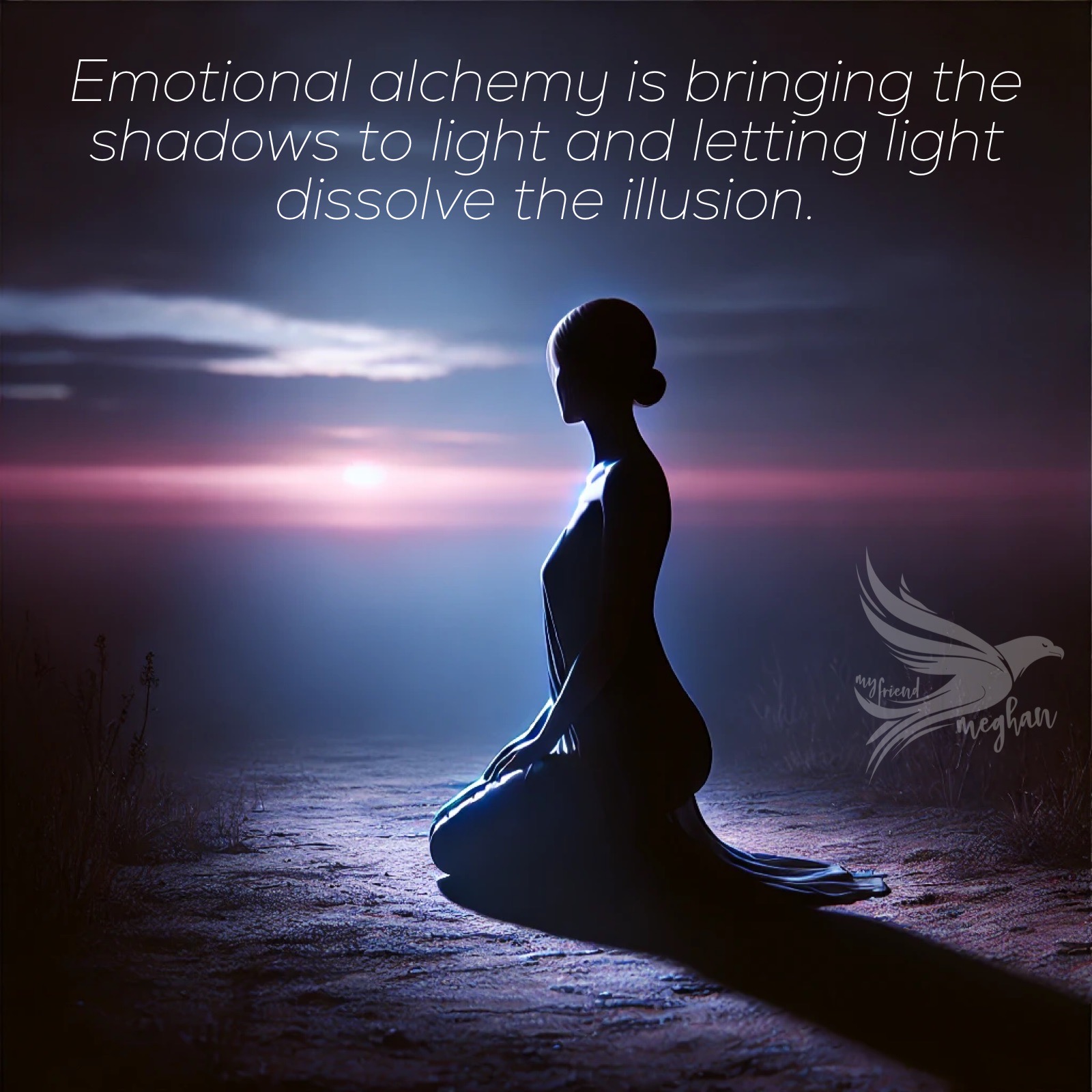The term “shadow work” gets thrown around a lot—but for something that’s so widely used, it’s often misunderstood. It can sound trendy or vague, like a spiritual catchphrase more than a grounded practice. Real shadow work isn’t just about acknowledging that we have a darker side or hidden patterns—it’s about doing the deep internal work (i.e. emotional alchemy) of facing those patterns, feeling what’s underneath, and allowing our false beliefs to dissolve in the light of awareness.
At its core, shadow work is about reintegrating the parts of ourselves we’ve rejected, denied, or ignored. It asks us to slow down, notice our emotional reactions, and become curious about where they come from. It’s not about forcing change. It’s about letting truth surface. And when we do that, we begin to alchemize the heaviness we carry—not by fixing it, but by finally seeing it clearly, allowing the illusion to fall away.
What Shadow Work Actually Is
Shadow work is the intentional process of uncovering unconscious beliefs, buried emotions, and disempowering patterns that influence how we see ourselves and interact with the world. These aren’t always obvious. In fact, they’re often so deeply embedded that we think they are us.
But our shadows aren’t inherently bad—they’re simply unconscious. They formed as protective responses to pain, rejection, or unmet needs. The goal of shadow work isn’t to eliminate these parts of us. It’s to meet them, hear them, and bring them into conscious awareness so they no longer control us from the background.
My Personal Process: Emotional Alchemy in Action
For me, shadow work begins with noticing when something hits me harder than it should—an emotional response that feels disproportionate to the moment. Instead of brushing it off or trying to override it, I pause and receive it with curiosity without judgment.
1. Identify and Own the Emotion.
The first thing I do is identify the emotion I’m feeling and sit with it. These emotions arise from the subconscious level, and are tied to deeper storylines and memory loops that are quietly running beneath the surface. Those are the patterns I chase down next—following them back to see what they’re connected to.
2. Find the Belief the Emotion is Tied To.
So next I trace the emotion back—asking myself where I’ve felt this before or what memory it connects to. Then I begin to question it gently, asking: What would I have to believe is true in order to feel this way? I sit with the question and allow whatever surfaces to rise—often quietly, intuitively, like something I already knew but hadn’t admitted. Usually, I find it links to a pattern or core belief rooted in the unconscious level, often something I internalized long ago but never consciously questioned.
3. Determine What Pattern or Loop May Be Causing the Belief to Repeat.
Once I’ve identified the belief, I start watching for how it shows up in my internal or external patterns. These are the loops—thoughts I find myself repeating, emotional reactions that feel familiar, or behaviors I default to without thinking. This is the terrain of the individual automatic mind, where beliefs quietly run the show through habit and unconscious response. Unless we bring awareness to these loops, they continue to shape our lives without our conscious consent.
Sometimes it’s hard to see these loops ourselves—especially when they’ve been running in the background for years. But this is something you can try doing on your own. Start by noticing when your emotional reaction feels bigger than the moment, and ask yourself what pattern or story might be underneath.
If it’s hard to spot on your own, you might try talking it through with a trusted friend or mentor, a coach or counselor, or even letting an AI reflect the patterns it notices based on what you share. Sometimes, just hearing your own story mirrored back can help you connect the dots.
4. Emotional Alchemy (Where the Magic Happens)
Once you’ve identified the emotion, traced it back to the core belief, and recognized the pattern or loop it’s tied to, you’re standing at the threshold of transformation. This is where emotional alchemy begins.
Emotional alchemy is the process of allowing awareness to dissolve illusion. You don’t have to wrestle with the belief or force it to change. Simply seeing it clearly—without judgment, without flinching—is often enough to begin shifting its energy. This is the heart of the practice: bringing what was hidden into the light, and letting that light dissolve the illusion. The misalignment becomes obvious, and the emotional charge that once surrounded it begins to weaken.
But this moment can feel raw and tender, especially when the belief has been held for a long time. That’s where intention and care matter. To support the alchemy, you can begin offering yourself the truth that was missing. This might look like working with affirmations that speak directly to the new, aligned belief. For example: I am allowed to rest. My worth isn’t measured by how much I do. I am enough, even when I’m still.
Sometimes what’s needed is deeper than words.
- A gesture of self-love, like placing your hand over your heart and breathing with compassion, can be just as powerful.
- Your inner child may need to be held, comforted, or gently reparented—that simply means offering the kind of love, reassurance, and understanding you once needed but didn’t receive.
- You might choose to journal, move your body, sit in stillness, or speak the truth aloud.
Whatever helps you feel the new belief in your system—not just think it—is part of the alchemical process.
Emotional alchemy means honoring what was true for you in the past and then choosing to anchor it in what is true for you now. It’s important not to bypass or pretend that you’re fine. When you bring love and presence to what was once hidden, the energy begins to transform, and you come back into alignment with your deeper self. This process of releasing what no longer serves creates space for a more empowered internal truth.
Alchemy in Action
Here’s a simple example of how I’ve walked through this process in real time:
I noticed I was experiencing a high level of anxiety—an emotion that’s not typically present for me—which helped me realize something deeper was at play. As I followed that emotional thread back, I uncovered a core fear of failure, specifically around an area where I had been repeatedly told I wasn’t good enough. Because I had internalized that messaging, I subconsciously expected to fail in that area, even when I had no present evidence to support that outcome.
Once I named the belief, I began to recognize the loop it had created: constantly questioning myself, doubting my discernment, and needing permission or outside validation to believe what I already knew deep down.
That’s when the real integration began. I sat with the emotion. I acknowledged the younger version of me who had been taught to doubt her inner knowing. I affirmed that my truth is real, and my discernment is trustworthy. That I no longer need permission to believe myself. That I don’t have to explain or justify what I know inside.
Those reframes didn’t just soothe the emotion—they began to restructure the belief beneath it. And each time I return to those truths, I reinforce a new pattern: one rooted in trust, not fear. This is what emotional alchemy looks like in real life.
Letting Go of the Old Story
So many of the stories we live by are inherited or unconsciously constructed. When we do shadow work, we start to see the role our beliefs have played in shaping our experiences. This echoes the Pygmalion effect (self-fulfilling prophecy)—what we expect, we subtly reinforce.
When we bring awareness to those internal expectations, we give ourselves the power to change the lens—not just to think differently, but to feel differently, too.
From that place, we can begin alchemizing with elevated thought. It’s not about pretending to be high-vibe or shoving pain under the rug. It’s about honestly witnessing what’s there—and letting truth do the work.
Actionable Insights
- Pause when you feel emotionally triggered. Instead of reacting or rationalizing, ask: What am I feeling, and what might this be pointing to underneath the surface?
- Gently explore the root belief behind the emotion. Ask yourself: What would I have to believe in order to feel this way? Sit with the question until something real surfaces.
- Notice when a belief starts to feel misaligned. If a belief feels false, outdated, or heavy, let yourself recognize that. You don’t have to fix it—just see it clearly.
- Rest in your reclaimed awareness. When something dissolves, let yourself breathe in that new space. You’re not broken—you’re becoming more whole.


Leave a Reply